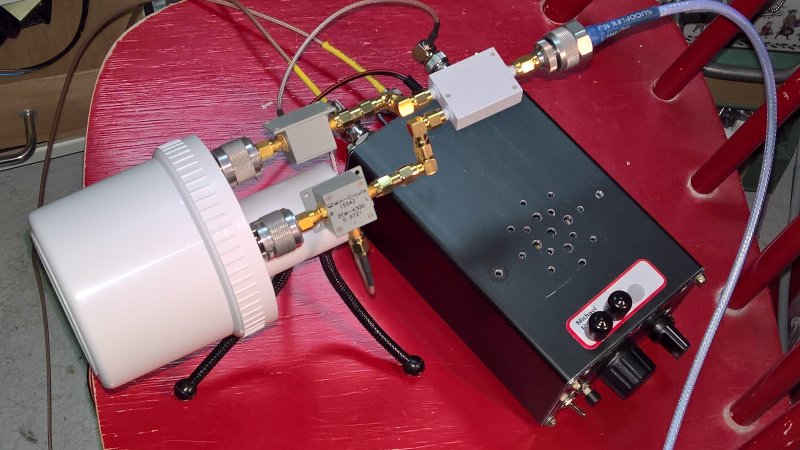 The OH2AUE HF Polarimeter with S Band Frequency Extender
The OH2AUE HF Polarimeter with S Band Frequency Extender The OH2AUE HF Polarimeter with S Band Frequency Extender
The OH2AUE HF Polarimeter with S Band Frequency Extender
- so I am into my fifth trisade mission year of replacing turnstiles and the like with circularly polarized tripoles (01.12.2018)
- my first attempts at HF polarimetry experimenting with crossed active tuned ferrite antennas, two modified AR-5000 receivers and an analogue oscilloscope in XY mode for polarisation display
- above photo of an o-mode CW carrier under normal propagation conditions, not for the faint-hearted, tuning for perfect quadrature is a bit challenging (01.06.2018)
- there tests were not entirely satisfactory due to undocumented 10 MHz External Rererenced PLL challenges in the receivers (01.06.2018)
- hence I constructed an experimental HF Polarimeter/Ellipsometer in an HF Layer1 Propagation Analyser (14.07.2018)
- I use this primarily for polarization and propagation analysis of NVIS HF signals
- front panel view of the prototype JUMAMI Polarimeter (01.8.2018)
- rear panel view of the prototype JUMAMI Polarimeter (01.08.2018)
- the ellipsometer baseband audio can also be recorded on an MP3 player and replayed on the XY oscilloscope for polarisation post-analysis
- my JUMAMI Ellipsometer/Polarimeter is based on two JUMA RX1 Front Ends, a prototype JUMA TRX1 Synthesizer and some bits and pieces (16.06.2018)
- check my YouTube Channel for sample videos of how this amazing instrument works in practise
- analogue oscilloscope sample (1ms/div) screenshot of a 989 km distant (oblique) emission with multipath propagation (14.07.2018)
- obvious features in the display are the longer propation path for the x mode (more propagation delay) and shorter (less attenuation) for the o mode path
- as an entirely different measurement method, these measurements correlate well with digital channel impulse measurements over a simultaneous similar path
- under these conditions and using a regular dipole or any kind of linearly polarized (oblique mode) antenna would result in multipath distortion with an echo of about 2.0 milliseconds in average
- under these conditions the time of flight for o mode measured about 3.3 ms and for x mode about 4.7 ms
- this particular path is in the High Latitude Northern Hemisphere, during peak summertime 2018. in the approximately 60m band
- continuously running into debates on polarization ellipticity or circularity and receiving questions on the subject during my training courses, I decided a frequency extender is needed
- S band is the obvious choise as I have accumulated an impressive collection of homebrew antennas for 2.4 GHz, especially tripoles and other multipole antennas
- my experimental polarimeter frequency extender covers 1.7 - 2.5 GHz with adequate phase and amplitude perfomance for producing reasonable results in open air testing (01.03.2019)
- here are some 2.4 GHz polarisation analysis results with the HF polarimeter equipped with the frequency extender: